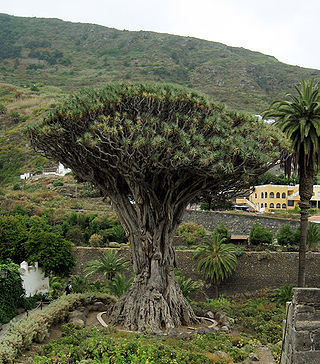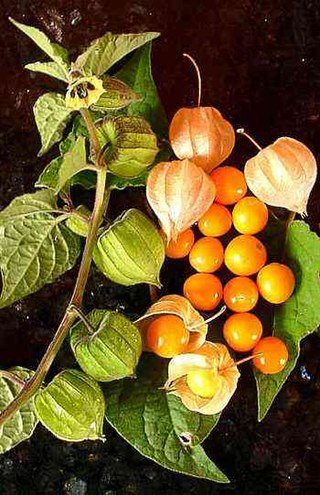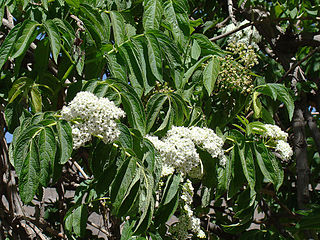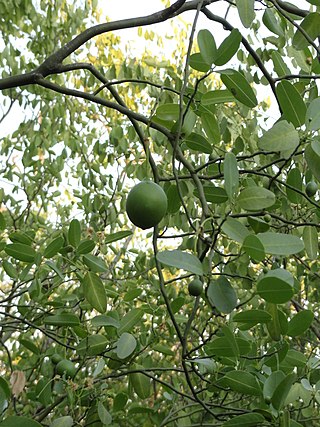
Dioscoreaceae is a family of monocotyledonous flowering plants, with about 715 known species in nine genera. The best-known member of the family is the yam.

In biology, a common name of a taxon or organism is a name that is based on the normal language of everyday life; and is often contrasted with the scientific name for the same organism, which is often based in Latin. A common name is sometimes frequently used, but that is not always the case.
Nomenclature is a system of names or terms, or the rules for forming these terms in a particular field of arts or sciences. The principles of naming vary from the relatively informal conventions of everyday speech to the internationally agreed principles, rules and recommendations that govern the formation and use of the specialist terminology used in scientific and any other disciplines.

Dracaena is a genus of about 120 species of trees and succulent shrubs. The formerly accepted genera Pleomele and Sansevieria are now included in Dracaena. In the APG IV classification system, it is placed in the family Asparagaceae, subfamily Nolinoideae. It has also formerly been separated into the family Dracaenaceae or placed in the Agavaceae.

Gesneriaceae, the gesneriad family, is a family of flowering plants consisting of about 152 genera and ca. 3,540 species in the tropics and subtropics of the Old World and the New World, with a very small number extending to temperate areas. Many species have colorful and showy flowers and are cultivated as ornamental plants.

Verbena, also known as vervain or verveine, is a genus in the family Verbenaceae. It contains about 150 species of annual and perennial herbaceous or semi-woody flowering plants. The majority of the species are native to the Americas and Asia; however, Verbena officinalis, the common vervain or common verbena, is the type species and native to Europe.

Physalis peruviana is a species of plant in the nightshade family (Solanaceae) native to Chile and Peru. Within that region, it is called aguaymanto, uvilla or uchuva, in addition to numerous indigenous and regional names. In English, its common names include Cape gooseberry, goldenberry and Peruvian groundcherry.

Knowltonia is a genus of the family Ranunculaceae. There are 25 species native to South Africa and Latin America. The juice from the stem of many of the species in the genus is a powerful vesicant.

Juncaginaceae is a family of flowering plants, recognized by most taxonomists for the past few decades. It is also known as the arrowgrass family. It includes 3 genera with a total of 34 known species.

Bonnetiaceae is a family of flowering plants, consisting of 4 genera and 41 species. The family is Neotropical, with the exception of the genus Ploiarium, which is found in Malesia. It is sister to the family Clusiaceae.

Ripogonum is a genus of flowering plants confined to eastern Australia, New Zealand, and New Guinea. Until recently this genus was included in the family Smilacaceae, and earlier in the family Liliaceae, but it has now been separated as its own family Ripogonaceae.

Sansevieria is a historically recognized genus of flowering plants, native to Africa, notably Madagascar, and southern Asia, now included in the genus Dracaena on the basis of molecular phylogenetic studies. Common names for the 70 or so species formerly placed in the genus include mother-in-law's tongue, devil's tongue, jinn's tongue, bow string hemp, snake plant and snake tongue. In the APG III classification system, Dracaena is placed in the family Asparagaceae, subfamily Nolinoideae. It has also been placed in the former family Dracaenaceae.
Morisonia heterophylla is a species of flowering plant in the family Capparaceae. It is native to Ecuador and Peru. Its natural habitats are subtropical or tropical dry forests and subtropical or tropical dry shrubland. It is threatened by habitat loss.

Sambucus peruviana is a species of tree in the family Adoxaceae. It is native to Central America and South America.

Morisonia hastata is a species of flowering plant in the caper family, Capparaceae. It is a tree native to the tropical Americas, including the Caribbean, Venezuela, Colombia, and eastern Brazil.

Hemionitis is a genus of ferns in the subfamily Cheilanthoideae of the family Pteridaceae. Its circumscription varies greatly in different systems of fern classification. In the Pteridophyte Phylogeny Group classification of 2016, it was one of more than 20 genera in the subfamily Cheilanthoideae, and was said to have five species. Other sources treat it as the only genus in the subfamily, and so accept about 450 species. With the restricted circumscription, species are native to tropical America.
Morisonia is a genus of flowering plants in the family Capparaceae, found across the Americas from the United States to Argentina. They are typically shrubs or small trees. The genus was recently enlarged with New World Capparis species due to existing taxonomic instability.
Ranunculus oz is a species of flowering plant in the family Ranunculaceae, native to all of Australia except the Northern Territory. Its specific epithet is a colloquialism for Australia.

Pamianthe peruviana, also known as the giant Peruvian daffodil, is a species of epiphytic plant native to seasonally dry areas of Peru and Bolivia.

Morisonia speciosa, commonly known as bola verde, is a species of tree in the family Capparaceae. It is native to the Gran Chaco region of Bolivia, Paraguay, western Brazil, and northern Argentina. It was formerly known under the scientific names Anisocapparis speciosa and Capparis speciosa. The fruit, seeds, and flowers of Morisonia speciosa are edible. The fruit is very sweet and has a spicy flavor reminiscent of mangoes. The Toba and Wichí peoples traditionally use it both culinarily and medicinally.















